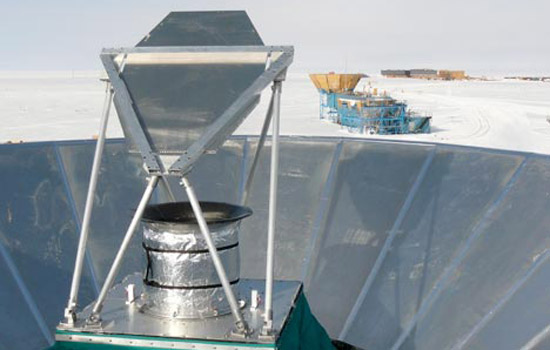RIT scientists hunt for gravitational waves
J. Brevik / Stanford University
BICEP2 calibration measurements at the South Pole in February 2010. The BICEP2 beam functions were measured by mapping a microwave source mounted above the nearby MAPO building, using a far-field flat mirror.
RIT scientists are looking for high-frequency gravitational waves using a different method than the team that earlier this week announced it had found low-frequency gravitational wave signals in the first light observed from the Big Bang.
The RIT group participates in an international collaboration using LIGO (the Laser Interferometer Gravitational Wave-Observatory) to explore Einstein’s prediction of gravitational waves produced by the collision of black holes, super novae and neutron stars spinning hundreds of times a second.
The groundbreaking announcement from scientists at Stanford and Harvard from the BICEP2 (Background Imaging of Cosmic Extragalactic Polarization 2) collaboration stunned the scientific community with news that they had observed the signature of gravitational waves generated during inflation—the exponential expansion of the universe following the Big Bang, 13.8 billion years ago.
"Before this observation of the effects of gravitational waves, their existence had only been predicted by Einstein's theory and inferred from their effects on the evolution of binary star systems,” said John Whelan, professor in RIT’s Center for Computational Relativity and Gravitation in the School of Mathematical Sciences and the Astrophysical Sciences and Technology Ph.D. program in the School of Physics and Astronomy, and the principal investigator of RIT’s group in the LIGO Scientific Collaboration.
Gravitational waves, while weak, penetrate where light waves cannot and introduce the possibility of gravitational-wave astronomy, a new way of collecting information about the universe.
The gravitational waves leading to the BICEP2 observations are extremely low frequency, containing only a few cycles in the history of the universe, Whelan notes.
Unlike BICEP2, the LIGO collaboration that RIT belongs to searches for gravitational waves at the other end of the spectrum from the cosmic microwave background. It focuses on gravity waves generated at a rate of tens to thousands of cycles per second. At these higher frequencies, the Advanced LIGO gravitational wave detector is anticipated, within the decade, to measure gravitational waves created by black holes and other astrophysical phenomena, and also to search for the inflation-produced background seen by BICEP2, Whelan said.
Besides Whelan, the RIT group that belongs to the LIGO Scientific Collaboration includes Manuela Campanelli and Carlos Lousto, professors in the School of Mathematical Sciences, and Hans-Peter Bischof, professor in the Department of Computer Science, from the Center for Computational Relativity and Gravitation.
“(BICEP2’s) result is remarkable both because of the apparent confirmation of the theory of inflation, which was proposed by MIT scientist Alan Guth in the 1980s to explain observations of the universe, and because of the detection of the imprint of gravitational waves on the cosmic microwave background,” Whelan said.
The BICEP2 telescope at the South Pole observed the swirling signature of gravitational waves in polarized light of the cosmic microwave background, the light echoes of the Big Bang. The team analyzed its data for more than three years, according to a press release from Stanford University’s SLAC National Accelerator Laboratory. Subsequent experiments over the next few years will test the results.













